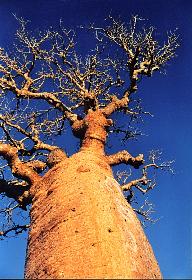Baobab, Adansonia fony
Order of Malvales, family Bombaceae (28 genera, 200 species), genus Adansonia
 Etymology: "baobab" comes from Arabic "bu hibab", "fruit in many seeds" or "Lobab", "nut" or "almond" (in De plantis Aegypti Liber of Prospero Alpina - Venice 1592). Etymology: "baobab" comes from Arabic "bu hibab", "fruit in many seeds" or "Lobab", "nut" or "almond" (in De plantis Aegypti Liber of Prospero Alpina - Venice 1592).
"Bombaceae", comes of bomba, idiom of equatorial Guinea.
The genus is named by Jussieu in honor of Michel Adanson, botanist and explorer (1727-1806), who describes it in 1749. He lived in the Senegal 6 years, and wrote a Natural history of the Senegal, which made reference. We owe him a botanical classification based on the physiology of plants.
Habitat: the baobab is in the semiarid regions of Madagascar (7 listed species of which Adansonia fony), in Africa (1 species Adansonia digitata) and in Australia (1 species).
Lifespan: 1 000 - 2 000 years.
Height: 20 metres high. Its breadth is exceptional: its trunk can approach 30 metres of circumference, that is 9,5 metres in diameters. Its form, narrower at the top, can be compared to a bottle. What is not wrong, because it consists of parenchymal tissue waterlogged. The baobab can store more than 120 000 liters of water to deal with prolonged drought.
Smooth, brown bark.
Leaves: deciduous, appearing between July and January. In the watered zones, the baobab can keep its leaves all year long.
Flowers: ephemerals, between May and August (north hemisphere). They are pollinated by the bald, at night.
Fruit: calabash, pendulous, of 30 cm long, called "monkey's bread" in Africa.
Tradition: emblem of the Senegal.
Use:
The chronicler Gomes Eanes de Zurara reports that "the fibrous part of its bark is actually a very good thread for ropes, and it burns similarly to linen. Its fruit is like gourds, which seeds are like hazelnuts, and they eat that fruit still green, and the seeds they are dry and they retain a lot and I think it must be for food after they lack the green "(in Cronica dos Feitosa of Guinea - Lisboa 1453) .
Leaves are notably used as antidiarrhoeic, febrifuge, anti-inflammatory and antifilarial. The powder of leaves dried out is antianaemic, antirachitic, tonic, emollient, anti-dysenteric, antiasthmatic and antirheumatic. The fruit, sour taste of which is rather agreeable, is used for the preparation of refreshing drinks. The trunk, hollowed out on foot, can act as shelter. Its wood does not serve in framework, but for the paper and for the manufacture of some musical instruments. The bark finally serves for making cordage. |
 Etymology: "baobab" comes from Arabic "bu hibab", "fruit in many seeds" or "Lobab", "nut" or "almond" (in De plantis Aegypti Liber of Prospero Alpina - Venice 1592).
Etymology: "baobab" comes from Arabic "bu hibab", "fruit in many seeds" or "Lobab", "nut" or "almond" (in De plantis Aegypti Liber of Prospero Alpina - Venice 1592).